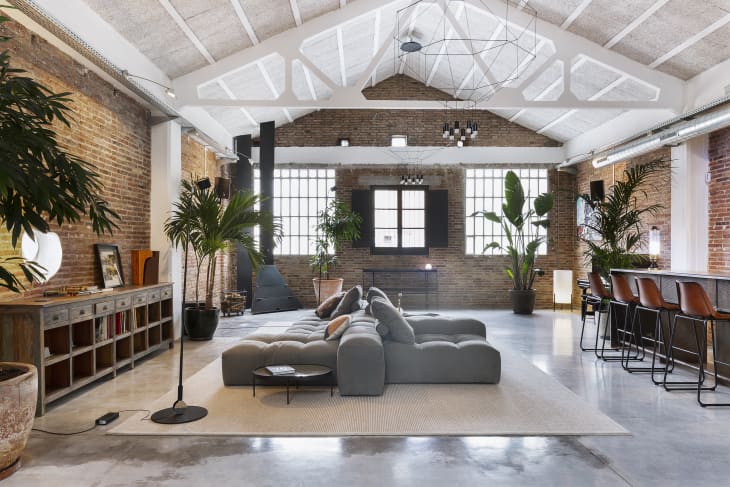Here’s Everything You Need to Know About Industrial Style

The early 2000s gave us more than just a decade of binge-worthy television—it put industrial design on the map, championing open-format spaces along with the allure of urban living. Whether it was Dan Humphrey’s edgy Brooklyn apartment in “Gossip Girl” or Jess Day’s converted loft in “New Girl,” exposed brick walls and massive, steel-paned windows suddenly became all the rage. Today, traces of industrial style can be seen in modern farmhouse and contemporary schemes, but the real deal is about as no-frills as it gets. “Industrialism adheres to a simple, strong aesthetic with a focus on the raw functionality of elements,” says designer Alison Giese. Repurposed pipes and uncovered ductwork are accentuated instead of concealed, finishes reminiscent of the Industrial Age are ever-present, and functionality always trumps all.
Industrial style by definition
Industrial style was basically born from spaces such as old factories, warehouses, or even old firehouses being reimagined or converted into livable, loft-like homes, explains designer Bailey Li. At its core, industrial style is all about taking something old, commercial, vintage, or recycled and giving it a second lease on life, without stripping it of its original character. Innately, the aesthetic is streamlined and minimalist, yet it has a “lived-in” quality to it that’s pretty hard to replicate. Here’s how to spot the hallmarks of industrial style:
- Pared-down color schemes built around darker hues (black, brown, and grays) with lighter, neutral accents
- Open-format spaces with tall ceilings that incorporate multiple living areas into one
- High-contrast pairings that typically feature polished and salvaged or raw materials like glass and wood
- Heavy use of metals such as iron, steel, copper, and brass
- Reclaimed wood paneling, exposed ductwork, and architectural beams
- Textured surfaces such as brick accent walls or concrete flooring
- Sleek, modernized finishes coupled with antique elements
The Industrial Revolution did more than just introduce new technologies and mechanize manufacturing—it offered a modern standard of living and paved the way for industrial style as it is known today. In the early 20th century, long after the boom of the movement, closed-down factories in far-out locales became a prime source of real estate, as urban communities buckled under the pressure of a rapidly growing population. Abandoned mills and warehouses were converted into livable quarters, and instead of altering or remodeling the framework, things were left as is. Financial constraints were, in part, a factor here, but the spacious layouts, coupled with massive windows and tall ceilings, appealed to those looking to escape cramped city living.
The decades that followed brought on an array of influential design styles that pushed the industrial aesthetic to the back-burner. While touches of this style were incorporated in the Bauhaus school, modern architecture, and even the wave of minimalism that took over in the ‘90s, it wasn’t until the last 20 or so years that industrialism regained popularity. Take, for example, the present-day fad of shipping container homes or converted garages, carriage houses, and churches, which are all byproducts of the historic alternative industrialism offered to traditional housing.
That said, industrialism has since evolved from a spatial or structural construct, asserting itself as a design style unlike any other. Instagrammable moments such as subway-tiled bathrooms with black, steel-paned showers or the edgy vibe made famous by brands such as Restoration Hardware embody the essence of industrial style. A heavy influence on contemporary design, you can find traces of industrial style across a wide array of interiors, whether it’s a one-room apartment with floor-to-ceiling windows and exposed pipes or a minimalist Scandi scheme that borrows bold details like steel and concrete for an impactful finish.
Industrial vs transitional
There are a handful of parallels between transitional design and industrial style—from the use of sturdy materials and reclaimed accents to the bold presence of metals such as wrought iron and steel. Where they differ, however, is the application of said elements. “Transitional is that eclectic blend of new and old, mixing modern and antique or vintage elements to create an interesting environment with loads of character and intrigue,” notes Li. Industrial style, on the other hand, allows you to see the rawness of a structure, down to its bones, the designer adds, and it stands alone aesthetically with little outside influence.
Industrial vs modern farmhouse
The use of texture is key among these two styles, as are vintage details, reclaimed finishes, and metals like iron or galvanized pipes. However, while industrial style can feel a bit more “rougher around the edges,” modern farmhouse incorporates clean and simple lines in a more refined way, explains Giese. Think of the latter as an artful blend of industrial with a country-chic spin.
How to get the industrial style look
Here’s how to recreate the best of industrial style at home:
- Paint a dark accent wall or hang up on-theme wallpaper (think concrete or wood-paneled motifs)
- Install statement lights (and lots of ‘em!) with exposed bulbs or caged pendants for an edgy touch
- Shop vintage and keep an eye out for repurposed furniture and upcycled decor
- Mix and match metals with glass—or leather with plywood—for a dynamic twist
- Opt for concrete slab counters or live-edge tables for raw, textural focal points
- Commission a local reclaimed wood supplier and furniture maker to create a one-of-a-kind piece, suggests Li—think along the lines of a multi-media door or shelving unit